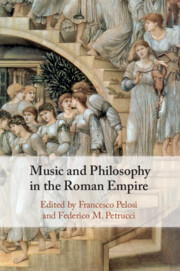Book contents
- Music and Philosophy in the Roman Empire
- Music and Philosophy in the Roman Empire
- Copyright page
- Contents
- Notes on Contributors
- Acknowledgements
- Abbreviations
- Introduction
- Chapter 1 The Scala Naturae and Music
- Chapter 2 Music and Plutarch’s Platonic Cosmos
- Chapter 3 The Harmoniser God
- Chapter 4 Alexander of Aphrodisias and Musical Models for Ontological Enquiries
- Chapter 5 How to Resist Musical Dogmatism
- Chapter 6 Shifting Epistemological Perspectives in Ptolemy’s Harmonics
- Chapter 7 Musical Imagery in Clement of Alexandria and Origen
- Chapter 8 Plotinus on Music, Rhythm, and Harmony
- Chapter 9 Porphyry’s Commentary on Ptolemy’s Harmonics
- Chapter 10 The Music of the Virtues in Late Ancient Platonism
- Chapter 11 Harmonics as Theological Paradigm in Proclus
- Chapter 12 Calcidius on Cosmic Harmony
- Chapter 13 Harmonia in Philoponus’ Commentary on Nicomachus’ Introduction to Arithmetic
- Bibliography
- Index Locorum
- General Index
Chapter 9 - Porphyry’s Commentary on Ptolemy’s Harmonics
Questions of Philosophic and Scientific Identity
Published online by Cambridge University Press: 27 November 2020
- Music and Philosophy in the Roman Empire
- Music and Philosophy in the Roman Empire
- Copyright page
- Contents
- Notes on Contributors
- Acknowledgements
- Abbreviations
- Introduction
- Chapter 1 The Scala Naturae and Music
- Chapter 2 Music and Plutarch’s Platonic Cosmos
- Chapter 3 The Harmoniser God
- Chapter 4 Alexander of Aphrodisias and Musical Models for Ontological Enquiries
- Chapter 5 How to Resist Musical Dogmatism
- Chapter 6 Shifting Epistemological Perspectives in Ptolemy’s Harmonics
- Chapter 7 Musical Imagery in Clement of Alexandria and Origen
- Chapter 8 Plotinus on Music, Rhythm, and Harmony
- Chapter 9 Porphyry’s Commentary on Ptolemy’s Harmonics
- Chapter 10 The Music of the Virtues in Late Ancient Platonism
- Chapter 11 Harmonics as Theological Paradigm in Proclus
- Chapter 12 Calcidius on Cosmic Harmony
- Chapter 13 Harmonia in Philoponus’ Commentary on Nicomachus’ Introduction to Arithmetic
- Bibliography
- Index Locorum
- General Index
Summary
After introducing Porphyry’s commentary, this chapter asks how Porphyry saw himself at the time of writing. Was it as a ‘Neoplatonist’ and pupil of Plotinus as usually presumed? Does he write as a mathematician and scientist or as a philosopher? Assuming he sees harmonics as a natural interest of the philosopher, what sort of philosopher does he represent himself as? He could claim to be embarking upon a ‘Pythagorean’ task rather than a ‘Platonist’ one, though the two were hard to distinguish in this era. Either would involve the Timaeus. His persona may have a bearing on the work’s date. The long discussion on logos and sensation is examined for indications of Porphyry’s sources and allegiance. This epistemology is distinctive, and the most distinctive features are independent of Plotinus. The section’s eclecticism and polymathy make it hard to associate with a single school, like Thrasyllus, Porphyry’s only named authority here. Porphyry’s persona is in fact complex, as much Pythagorean as Platonist, with an early dating feasible, allowing for debts to Longinus and to the mathematician Demetrius rather than to Plotinus. A Pythagorean’s interest in harmonics is natural.
- Type
- Chapter
- Information
- Music and Philosophy in the Roman Empire , pp. 198 - 226Publisher: Cambridge University PressPrint publication year: 2020



